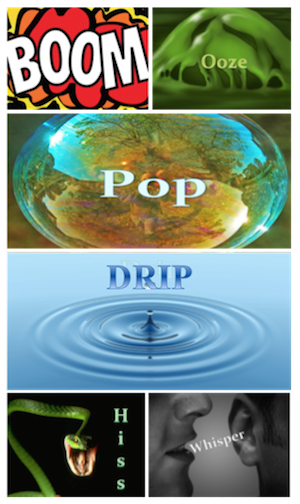4.1 Read About
4.1G Fossils and Creative Tools: Alliteration, Onomatopoeia, & Personification
What is Alliteration:
Example: "Seven sisters slept soundly on the sand."
- the repetition of the beginning sounds in neighbouring or nearby words.
- creates a pattern that is memorable and makes you pay attention.
- is fun to say and enjoyable to hear.
Where have you heard it before?
- Many familiar expressions use alliteration. These include "down in the dumps" and. "turn the tables."
- Tongue twisters use alliteration.: "rubber baby buggy bumpers.
- Advertising
- Many sayings such as these use alliteration:
- He who laughs last laughs first.
- Time and tide wait for no man.
Remember: Alliteration is a repetition of sound, not letters, so look carefully when trying to identify it.
Alliteration and Poetry
While reading the following poem out loud, imagine fossils and skeletons of extinct creatures having a rowdy and lively gathering. Can you find examples of alliteration in two lines of this poem?
(Written in 1949 to accompany one section of The Carnival of the Animals, an entertaining musical suite of fourteen songs.)
 |
Complete the alliteration activity in your Learning Guide. |
Listen to the music for which Ogden Nash wrote Fossils. Do you think the xylophone sounds like the "clatter of their bones"?
Onomatopoeia is a word that imitates the sound it represents.
How to pronounce onomatopoeia:
 Examples:
Examples:
splash, wow, gush, kerplunk
Such devices bring out the full flavour of words. When these sound words occur, it is called onomatopoeia (a Greek word meaning name-making for the sounds literally make the meaning.)
Why use onomatopoeia in poetry? It is so descriptive and helps us to imagine what is happening.
More Examples of Onomatopoeia:
- Words related to air: flutter, gasp, swish, swoosh, whisper, whoosh, whizz, whip.
- Words related to animals: chirp, woof, purr, buzz, cluck, cock-a-doodle-doo, baa, hiss, meow, moo, neigh, oink, quack, ribbit, tweet.
- Words related to collisions and fights: bam, bang, boom, clang, clank, clap, clatter, click, clink, ding, slam, screech, slap, smash, thud, thump.
- Words related to the voice: chatter, blurt, giggle, growl, grunt, gurgle, mumble, murmur, belch, shiver.
- Words related to water: splash, spray, sprinkle, squirt, drip, drizzle, pitter patter, sloshes, plop.
Can you find one example of onomatopoeia in the excerpt from this poem?
“FOSSILS” by Ogden Nash
At midnight in the museum hall,
The fossils gathered for a ball,
There were no drums or saxophones,
But just the clatter of their bones...
 |
Complete the onomatopoeia activity in your Learning Guide. |
- The wind screamed out in sorrow to the moon.
The wind is not alive. It doesn't have a voice to scream with and it doesn't have emotions. Here are a few more examples.
- The friendly gates welcomed us.
- The Earth coughed and choked in all the pollution.
- The flowers danced in the wind.
Watch the video to learn even more about personification.
Can you find two - three examples of personification in this poem? This may be a little bit trickier than finding the alliteration and onomatopoeia.
“FOSSILS” by Ogden Nash
At midnight in the museum hall,
The fossils gathered for a ball,
There were no drums or saxophones,
But just the clatter of their bones,
Rolling, rattling carefree circus,
Of mammoth polkas and mazurkas,
Pterodactyls and brontosauruses
Sang ghostly prehistoric choruses,
Amid the mastodonic wassail I caught the eye of one small fossil,
“Cheer up sad world,” he said and winked,
“It’s kind of fun to be extinct.”
 |
Complete the personification activity in your Learning Guide. |